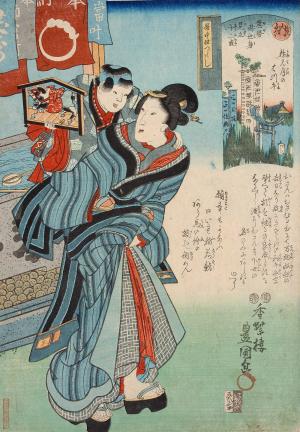Ise Calendar Selection, Dedication of the 12 signs of the zodiac, The first day of the horse in Umemi-duki, the second month of the lunar calendar, Collection of Inscriptions on the middled row of Calendar (Isegoyomi Mitate Jūnichoku Osan Umemizuki no Hatsu-uma Koyomi Chūdan Dukushi)
Painted by Utagawa Toyokuni III Around 1847-1848 (Kōka 4-Kaei 1) Tokyo Shiryō Collection 074-C6-2
This work depicts a mother and child enjoying the Edo Hatsu-uma Festival, a renowned festival of Edo. According to the note on the painting, offering to a deity the ema picture of a horse that the child is holding will fulfill one's wishes.
There were so many inari shrines in Edo that there was the saying "Iseya, inari and dog droppings". These inari shrines all put on a festival simultaneously on the first day of horse in the second month of the lunar calendar and this was the Hatsuma Festival.
Unlike the Hatsuma Festival of today, in the Edo period, this was a colorful festival with performances accompanied by flutes and drums and kagura dedications. Children would bang the drum and dance and the noise of festivities are said to have lasted until late.
One other essential part of Hatsuma was the dyed banner (somenobori) included in the picture. Brightly colored decorative lanterns (torokazari) and paper lanterns (andon) were also a feature of the festival and it appears that there were orderly lines of paper lanterns on the pathways leading into shrines.
The title 'Isegoyomi'(biased view of the times) is a homonym of 'Ise calendar' and 'junichoku' refers to good and bad luck about days and time or directions described on the calendar which was also called 'chudan' (middle row) because they were written on the middle of the fortune-telling calendar.


